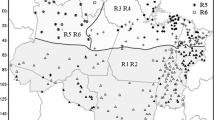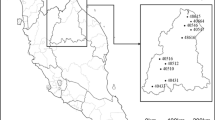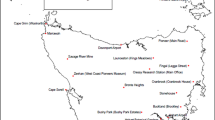Abstract
The two primary approaches of extreme events analysis are annual maximum series (AMS), which fits Generalized Extreme Value (GEV) distribution to the yearly peaks of events in the observation period, and partial duration series (PDS), which fits Generalized Pareto (GP) distribution to the peaks of events that exceed a given threshold. The PDS is able to reduce sampling uncertainty and is more useful in dealing with extreme values and asymmetries in the tails, but the optimal threshold is required. The objective of this study is to compare and determine the best method for selecting the optimal threshold of PDS using the hourly, 12-h and 24-h aggregated data of rainfall time series in Peninsular Malaysia. The choice of the threshold, or the number of largest order statistics, can be estimated by the parameters of extreme events. In this study, thirteen semi-parametric estimators are considered and applied to estimate the shape parameter or extreme value index (EVI). A semi-parametric bootstrap is then used to estimate the mean square error (MSE) of the estimator at each threshold and the optimal threshold is selected based on the smallest MSE. Based on the smallest MSE, the majority of stations and data durations favor the Adapted Hill estimator, followed by the QQ, Hill and Moment Ratio 1 estimators. Therefore, this study proves that the application of different estimators on real data may result in different optimal values of threshold and the choice of the best method is very much data-dependent.








Similar content being viewed by others
References
Anagnostopoulou C, Tolika K (2012) Extreme precipitation in Europe: statistical threshold selection based on climatological criteria. Theor Appl Climatol 107:479–489
Balkema AA, de Haan L (1974) Residual life time at great age. Ann Probab 2:792–804
Begueria S (2005) Uncertainties in partial duration series modelling of extremes related to the choice of the threshold value. J Hydrol 303:215–230
Beirlant J, Teugels JL, Vynckier P (1996a) Practical analysis of extreme values. Leuven University Press, Leuven
Beirlant J, Vynckier P, Teugels JL (1996b) Tail index estimation, pareto quantile plots, and regression diagnostics. J Am Stat Assoc 91(436):1659–1667
Beirlant J, Figueiredo F, Gomes MI, Vandewalle B (2008) Improved reduced-bias tail index and quantile estimators. J Stat Plan Inference 138:1851–1870
Bernardara P, Schertzer D, Sauquet E, Tchiguirnskaia I, Lang M (2008) The flood probability distribution tail: how heavy is it? Stoch Environ Res Risk Assess 22:107–122
Caers J, Maes MA (1998) Identifying tails, bounds and end-points of random variables. Struct Saf 20(1):1–23
Danielsson J, Jansen DW, De vries CG (1996) The method of moments ratio estimator for the tail shape parameter. Commun Stat Theory Methods 25(4):711–720
Davidson R (2012) Statistical inference in the presence of heavy tails. Econom J 15(1):C31–C53
Deheuvels P, de Haan L, Peng L, Pereira TT (1997) Comparison of extreme value index estimators. NEPTUNE T400:EUR-09
Deidda R (2010) A multiple threshold method for fitting the generalized pareto distribution to rainfall time series. Hydrol Earth Syst Sci 14:2559–2575
Dekkers ALM, de Haan L (1989) On the estimation of the extreme-value index and large quantile estimation. Annal Stat 17(4):1795–1832
Embrechts P, Klüppelberg C, Mikosch T (1997) Modelling extremal events for insurance and finance. Applications of Mathematics, Springer
Engeland K, Hisdal H, Frigessi A (2004) Practical extreme value modelling of hydrological floods and droughts: a case study. Extremes 7:5–30
Fisher RA, Tippett LHC (1928) Limiting forms of the frequency distribution of the largest or smallest member of a sample. Math Proc Camb Philos Soc 24(02):180–190
Fraga Alves MI (1995) Estimation of the tail parameter in the domain of attraction of an extremal distribution. J Stat Plan Inference 45:143–173
Fraga Alves MI, de Haan L, Lin T (2003) Estimation of the parameter controlling the speed of convergence in extreme value theory. Math Methods Stat 12:155–176
Fraga Alves MI, Gomes M, de Haan L, Neves C (2009) Mixed moment estimator and location invariant alternatives. Extremes 12:149–185
Gnedenko B (1943) Sur la distribution limite du terme maximum d’une serie aleatoire. Ann Math 44(3):423–453
Gomes MI, Canto E Castro L, Fraga Alves MI, Pestana D (2008) Statistics of extremes for iid data and breakthroughs in the estimation of the extreme value index: Laurens de haan leading contributions. Extremes 11:3–34
Gonzalo J, Olmo J (2004) Which extreme values are really extreme? Journal of Financial Econometrics 2(3):349–369
Hill BM (1975) A simple general approach to inference about the tail of a distribution. Ann Stat 3(5):1163–1174
IPCC (2007) Climate change—the physical science basis. Cambridge University Press, United Kingdom
Katz R, Parlange M, Naveau P (2002) Statistics of extremes in hydrology. Adv Water Resour 25:1287–1304
Kouchak AA, Nasrollahi N (2010) Semi-parametric and parametric inference of extreme value models for rainfall data. Water Resour Manag 24:1229–1249
Kratz M, Resnick S (1996) The qq-estimator of the index of regular variation. Commun Statist Stochastic Models 12:699–724
Lana X, Burgueno A, Martinez M, Serra C (2006) Statistical distributions and sampling strategies for the analysis of extreme dry spells in catalonia (NE Spain). J Hydrol 324:94–114
Li Y, Cai W, Campbell EP (2005) Statistical modeling of extreme rainfall in Southwest Western Australia. J Climate 18(6):852–863
von Mises R (1936) La distribution de la plus grande de n valeurs. Revue Math Union Interbalcanique 1:141–160; Reprinted in selected papers of Richard von Mises II (1964) Am Math Soc 2:271-294
Pandey MD, Van Gelder PHAJM, Vrijling JK (2003) Bootstrap simulations for evaluating the uncertainty associated with peaks-over-threshold estimates of extreme wind velocity. Environmetrics 14(1):27–43
Pereira TT, Galambos J, Lechner J, Simiu E (1994) Second order behavior of domains of attraction and the bias of generalized pickands’ estimator. In: Extreme value theory and applications III, vol 866. NIST special publication, pp 165–177
Pickands J (1975) Statistical inference using extreme order statistics. Ann Stat 3(1):119–131
Segers J (2005) Generalized pickands estimators for the extreme value index. J Stat Plan Inference 128:381–396
Shinyie WL, Ismail N (2012) Analysis of t-year return level for partial duration rainfall series. Sains Malays 41(11):1389–1401
Um MJ, Cho W, Heo JH (2010) A comparative study of the adaptive choice of thresholds in extreme hydrologic events. Stoch Environ Res Risk Assess 14:611–623
Yun S (2002) On a generalized pickands estimator of the extreme value index. J Stat Plan Inference 102(2):389–409
Zakaria ZA, Shabri A, Ahmad UN (2012) Regional frequency analysis of extreme rainfalls in the west coast of peninsular Malaysia using partial l-moments. Water Resour Manag 26:4417–4433
Zhao L, Xia J, Sobkowiak L, Wang Z, Guo F (2012) Spatial pattern characterization and multivariate hydrological frequency analysis of extreme precipitation in the pearl river basin, China. Water Resour Manag 26:3619–3637
Acknowledgements
We acknowledge the financial support of the Universiti Kebangsaan Malaysia (UKM-DLP-2012-015). We thank the Department of Irrigation and Drainage for providing the hourly rainfall data. We are also immensely grateful to the reviewers for their constructive comments.
Author information
Authors and Affiliations
Corresponding author
Rights and permissions
About this article
Cite this article
Shinyie, W.L., Ismail, N. & Jemain, A.A. Semi-parametric Estimation for Selecting Optimal Threshold of Extreme Rainfall Events. Water Resour Manage 27, 2325–2352 (2013). https://doi.org/10.1007/s11269-013-0290-7
Received:
Accepted:
Published:
Issue Date:
DOI: https://doi.org/10.1007/s11269-013-0290-7




